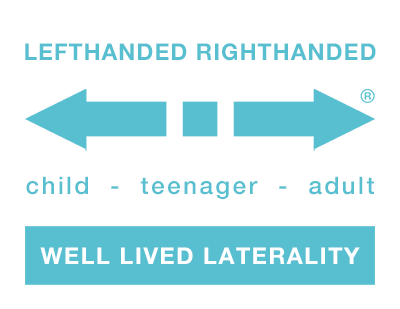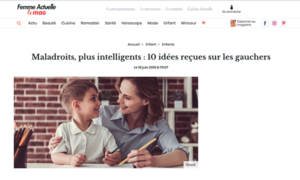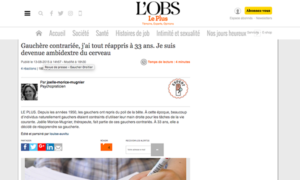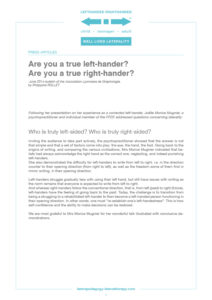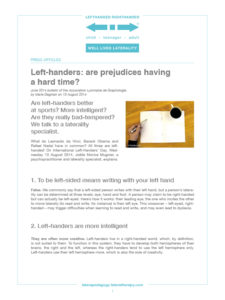"Right-Left Laterality for children" web conference
« Lefthanded » sud radio
« Lefthanded »
Sud Radio
Podcast coming soon
« Left-handed, the other meaning of life » TAMTAM Agence - Place à la santé
« Left-handed, the other meaning of life »
TAMTAM Agence – Place à la santé
"Left-handed revenge" TF1 - 13 pm Journal
« Left-handed revenge »
TF1 – 13 pm Journal
In the aftermath of the international leftist party of 13 August 2013 in Brive la Gaillarde
Video coming soon
The two-way slate « ® in demonstration on the video (ESAT manufacture) on sale on www.lamaingauche.com
«Are you a real lefthanded person? Are you a true righthanded person?» RMG38 - Prévention Santé
« Are you a real lefthanded person? Are you a true righthanded person? »
RMG38 – Prévention Santé
Joëlle Morice Mugnier answers your questions live!
« Lefthanded: chance or difficulty? » Europe 1 - Les Experts
« Lefthanded: chance or difficulty? »
Les Experts – Europe 1
Héléna Morna invites Joëlle Morice Mugnier
« Lefthanded: How to help? » Radio Notre Dame - En Quête de Sens
Clumsy, More Intelligent: 10 Misconceptions about Left-Handers
Read online
Left-handers are more intelligent than right-handers; they are often better at sports, but they’re clumsy and their hand-writing is usually messy… Let’s take a look at some misconceptions about left-handers.
As the left hand was long used for washing, it was considered the “bad / wrong hand”, the “the devil’s hand”. The right hand, however, was used for respectable tasks (writing, eating…). Left-handers were constantly corrected. In the 20th century, things gradually changed and left-handers have been “allowed”. Today, about 14% of the European population are left-handed. But the figures remain misleading: only fully left-handed individuals are taken into account, when in fact there are various types of left-sidedness.
Did you know that there are various types of left-sidedness?
As we know, you can be left-handed (the visible and therefore best-known type of left-sidedness), but you can also be left-eyed, left-footed or left-eared.
You can be partly right- and left-sided, i.e. have a crossed laterality. And all combinations are possible: for example, you can be left-handed and right-eyed and right-eared. Or you could be right-handed and left-eyed and left-eared…
Do you know whether you are left-sided at some level? There may be signs.
Visible or noticeable signs such as writing with the right or left hand are taken as the usual indication.
Laterapedagogical tests have been designed to identify the other forms of left-sidedness (eye, ear, foot).
However, some symptoms may be an indication and justify a consultation:
– dyslexia (difficulty reading, mirror-inversion of the letter d and b for example, often because of the leading left eye);
– headaches;
– tinnitus;
– ophthalmic pains;
– attention disorder, poor concentration…
Thanks to Joëlle Morice Mugnier, Vittoz psychopractitioner, laterapractitioner and author of Gauchers de la main ? Droitiers de l’œil ?, published by Editions Pierre Téqui, www.gaucher-droitier.com
My child is left-handed. How can I help him/her to adapt?
My child is left-handed. How can I help him/her to adapt?
Sylvie Roy, Docteur en pharmacie
Read online
Today, children are no longer forced to write with their right hand. Yet, our daily environment remains exclusively centred around right-handers. How can you best support a left-hander in their daily life? Sylvie Roy, doctor in pharmacy, refers to experts Florence de Montesquieu, a graphotherapist and writing physiotherapist and a graphotherapy trainer, and Joëlle Morice Mugnier, a Vittoz psychopractitioner and the creator of laterapedagogy, and gives a few tips to help left-handed children deal with their uniqueness.
An Environment Designed by and for Right-Handers
Today, left-handed children are no longer corrected. However, our environment is still designed by and for right-handers:
- the reading and writing direction
- the representation of time
- the presentation of mathematical equations
- everyday objects: books, tin-openers, scissors and pencil sharpeners.
Consequently, left-handers have to adapt, often with considerable and unknown effort – causing all sorts of issues. Florence de Montesquieu, a graphotherapist, writing physiotherapist and graphotherapy trainer, and Joëlle Morice Mugnier, Vittoz psychopractitioner and creator of laterapedagogy, share their view on left-handedness.
The Eye-Hand-Foot-Ear System – The Laterality Factor
The brain functioning of 13% of left-handers, i.e. 8 million people in France, works counter to the dominant direction. The dominant hand is only one indicator of the functioning mode. The hand chosen to write is not enough to assess a child’s laterality; the whole eye-hand-foot-ear system needs to be considered. It may or may not be a homogenous combination. For example, if the child is left-eyed, left-handed, left-footed and left-eared, or right-sided at all levels, he/she is said to have a homogenous system. But they could also be left-eyed, right-handed, left-footed and left-eared or any other crossed combination.
Eye Laterality – The Reading and Writing Factor
Note, however, that eye laterality is complex. The eye selected to aim at a distant, centred and static target is called the dominant eye. The eye that leads when reading or following our writing, up close and for dynamic vision, is called the leading eye. Here too, there may be a heterogeneity with a dominant right eye and a leading left eye. It is important to detect these characteristics early, that the child be aware of them, so they can best adapt.
The Eye-Hand-Foot System Develops Certain Areas of the Brain
The preferred eye-hand-foot system trains one of the brain hemispheres to specialize in a certain type of activities.
The Corpus Callosum is more Developed in Left-Handers
As a result, 95% of right-handers have a dominant left hemisphere for speech. While 70% of left-handers also use their left hemisphere for speech, the other 30% use the right hemisphere. Among left-handers, the structure that connects the two hemispheres, called corpus callosum is more developed because the transfer of information is more intense.
A Different Handling of Information Depending on the Hemisphere
The handling of information is different if it occurs in the right or left hemisphere. It is considered that the left hemisphere does an analytical, rational sort, whereas the right favours an overall, more intuitive view of things. This tendency, combined with adapting abilities developed from an early age, would explain why quite a few geniuses have been left-handed.
Left-Handers, Creative Individuals
Famous left-handers include Leonardo da Vinci, Johann Sebastian Bach, Ludwig van Beethoven, Robert Schumann, Charlie Chaplin, Alexandre Dumas, Edgar Allan Poe, Bill Clinton, Barack Obama, Bill Gates… Generally speaking, we note two types of left-handers:
- artists with cognitive and manual abilities: left-handers would have skills for spatial representation and rhythm. Cognitive and manual abilities make them more likely to do well in art, music, mathematics, architecture;
- sport performers: left-handers excel in sports of opposition, such as tennis (John Mc Enroe, Rafael Nadal…), table tennis, boxing, fencing, judo.
In their case, the “reflex” neuronal circuit uses one hemisphere only, unlike right-handers whose right eye transmits the information to the left hemisphere. In practical terms, the left-hander’s arm reacts faster than that of the right-hander. This is often a decisive asset over the opponent.
A Uniqueness not so Easy to Live with
Before this singularity may be turned into an advantage, the path may be tough for the left-handed child as soon as they enter a collective environment. The difference may be ill-received by the child depending on their:
- gender: girls in particular struggle with this gap in relation to the “norm”. The term “gendered inhibition” is used to refer to this significant gap between the number of left-handed girls and boys;
- body: writing against their opening direction causes tension in their fingers, wrist, back and may even cause a scoliosis;
-
- education: the effort experienced to read from left to right can lead to headaches, ophthalmic pains, poor concentration in turn leading to poor comprehension, memorization and restitution. In some cases, the block may manifest itself as dyslexia;
- personality: psychologically, the difference may lead to bad experiences, e.g. the child may be criticized for their lack of tidiness, they may lag behind their peers. The teacher may lose patience… The school experience can be tricky.
Discovering Left-Handedness before they Learn to Read and Write
The great majority of young children chose a hand to use a pen placed in front of them (in the centre). The situation is then clear: they are clearly either right- or left-handed. However, between age 5 and 7, 20% of children still hesitate between their right and left hands. Joëlle Morice Mugnier identifies them as individuals who are left-handed but do not know it, who keep it in check. Consequently, there is an internal conflict. The child may choose between asserting their left-handedness or correcting him/her-self. People around them will see them as ambidextrous.
Respect the Child’s Choice
The child needs time to freely decide, and the pen should always be place in the middle of the sheet of paper. This hesitation may last until preschool (until age 5 or so). It is important that the teacher have a neutral attitude towards the choice of hand. Most children make a choice before primary school. If not, the psychomotor assessment in the last preschool year can help to identify the choice.
Tips to Help Left-Handers
Left-handers tend to write above the line with a tense hand in a “swan’s neck”. Writing is painful, slow and the work often messy. A physiotherapy will aim to reposition the left hand under the line as early as possible to improve precision, speed and flexibility. Several tips can help the work:
- posture: feet flat on the floor, forearms on the table, no tightness in the neck or back. As they learn to write, the child needs to lean their chest against the table. A tilted surface makes their forearm more comfortable.
- the pen: let your child try various pens. There are pens for left-handers. Rollerball pens can also be more comfortable to use.
- the sheet of paper: it must be turned to the right a little. Any model to copy should also be placed on the right. The teacher must remember to place a left-handed pupil on the left when twin desks are in use.
- patience: children who do not have a tidy hand-writing do not do so on purpose and could lose their motivation if regularly criticized by the teacher or other pupils.
- legibility: whatever the flaws in their writing (size, alignment), encourage them. It is important that the child be able to read back what they wrote and be understood by others.
These practical adjustments change everything, and require the teacher’s full cooperation. As a parent, make an appointment as early as possible before the school year starts.
Laterapedagogy: over 20 Years of Research
Joëlle Morice Mugnier, a corrected left-hander, has developed a method for left-handers over 20 years with an aim to rehabilitate their left-handedness and support their adaptation. She teaches her pedagogy to orthoptists, graphotherapists, physiotherapists, speech therapists. She has also designed various tools that are compatible with a right-to-left opening direction (e.g. tracing paper notebook for mirror writing). Today, there is a network of professionals that draws on laterapedagogy in Paris, Lyon, Nantes, south-western France, Belgium and Canada. The network has a double focus.
1st Focus Point: Awareness of the Natural “Opening” Direction
The first focus point consists in becoming aware of the natural “opening” direction thanks to a thorough work with graphics by alternating left-to-right and right-to-left. A 5-minute daily practice, over a 3-week period re-establishes good connections.
2nd Focus Point: Use of Both Writing Directions
In the second instance, other exercises, practised with the same regularity over a 21-day period help with adaptation. The left-handed person is encouraged to use both writing directions to reconnect the correct circuits and eventually disentangle the mind, while stepping out of failure and judgment. If a child does “mirror” writing, it is important to be positive. Rather than say “You wrote the wrong way round”, you can simply observe that, “that’s the correct opening direction for you”. Allowing oneself to be left-handed can involve, for example, the use of the tracing paper notebook (patented by JMM) for poetry in class. Some teachers are happy with this practice. The child draws the picture on the left and writes the text on the tracing paper from right to left.
The key thing is to bear in mind that the final aim is to help the left-handed child to integrate into the world, to enable them to progress at the same pace as the others and be able to express their full potential. For a struggling left-hander, multidisciplinary support will help them to write legibly, fast and without pain.
As a corrected left-hander, I learnt everything at 33. I became brain-ambidextrous
As a corrected left-hander, I learnt everything at 33. I became brain-ambidextrous
13 aout 2015 : LE PLUS, By Joelle Morice-Mugnier Psychopractitioner
Read online
ON THE PLUS SIDE. Since the 1950s, left-handed people have bounced back. In those days, many naturally left-handed individuals were forced to use their right hand for everyday tasks. Joëlle Morice Mugnier, therapist, is one of those corrected left-handers. At the age of 33, she decided to relearn her left-handedness.
I have always been left-handed but, like many people of my generation, I was prevented from using my left hand.
Primary school teachers would force me to write with my right hand. They would sometimes hit my left fingers with a metal ruler to stop me from using my left hand. Other teachers would tie the pupil’s left hand to a bar of the chair so they could not use it. This was very common in the 1960s.
So I learnt to write exclusively with my right hand. The issue is that left-handedness is not just a question of hand; it is also a matter of brain.
I am both left-handed and left-eyed.
Learning to write with my right hand was not too much of a problem, but I am a homogenous left-sided person. This means that I use my left eye to read. On that level, no one could force me otherwise.
But our society works according to an established system designed for the right-handed, be it with regards to the reading direction or the way we think. For example, imagine a time line: you always picture it from left to right.
This is most likely why I often failed at school. I often refused to read because it did not suit me as it was.
Later on, I did orthoptic tests that allowed me to have a binocular vision. I am now able to use either brain hemisphere. My concentration is more fluid and I no longer have this pain across my forehead that prevented me from being comfortable with what I was doing.
After being right-handed for 33 years, I became left-handed.
I suffered this corrected left-sidedness for 33 years, but when I started as a therapist, I had to work on myself. I then realized that I had to become left-handed again. My right hand could write, but my eye was not good. In my brain, things were not organized.
To avoid frustration, it is important to go along with the opening direction. As things are, all left-sided people are hindered by the reading direction. Many must adopt an ill-suited posture when writing.
So I decided to create a therapy and a pedagogy to enable them to be more at ease with their left-sidedness: lateratherapy and laterapedagogy. This enables each person to find their correct laterality and see it as part of a whole. Because there is not one but many kinds of left-sidedness.
I have learnt to be brain-ambidextrous.
I have re-learnt to use space and adapt my movements according to my left-sidedness. After having used my right side for so long, I learnt to be ambidextrous. I can easily use either hand or eye. This is what we call “uni-cerebral” or brain-ambidextrous.
But is my left-sidedness hereditary? Through my work, I realized that my father was also left-handed, but that he had chosen to ignore it. Two of my siblings, for their part, discovered that they were left-handed once adults. By mimetism, in order not to feel excluded from any group, they had learnt to be right-handed, to adapt. My elder sister was a corrected left-hander like me.
Remember that the left hand was long deemed the devil’s hand, the one used for lowly tasks.
After doing many tests, I concluded that the number of left-handers could be much greater than it would seem: out of 1,000 right-hand users, nearly 53% are left-eyed.
I use a tracing paper notebook to mirror write.
On a daily basis, left-handers need certain tools to improve their everyday life. For my part, I have bought a ladle with a spout on the right, a pencil sharpener and a corkscrew that go the “right” way round. Scissors are fine as I have learnt to cut with my right hand.
I have never really experienced difficult situations since I can actually use my left and my right equally well.
However, to make my life easier, I systematically have a tracing paper notebook with me that we developed with Canson. This enables me to mirror write. You turn the page over and a right-handed person can read what is written from left to right. This helps me to think more clearly and makes me use my good eye, the left one.
I dream of an ambidextrous world.
Corrected left-handers are increasingly rare. I sometimes have young patients but the cases get fewer – which proves that it is no longer a flaw to be left-handed.
Primary school teachers make more and more efforts to acknowledge left-handed pupils by allowing them to sit on the left-hand side of the desk or letting them tilt their exercise book, but some still lack in awareness and need the training.
I believe that the situation for left-handers in our society is constantly improving. And computer keyboards are perhaps the best example as they are designed for both right- and left-handed users. It does not force you to write from left to right. However, with regards to reading on screen, it is recommended to reduce the visual span to reduce the width of the text. The counterflow of reading will be minimized.
But don’t hold your breath! Society will never fully adjust to left-handers, and this is not what I am asking for, but maybe one day it will think more ambidextrously. I am also convinced that right-handers would also truly benefit from using both brain hemispheres.
Article on Psychologies.com - Left-Handed : Between Luck and Difficulty
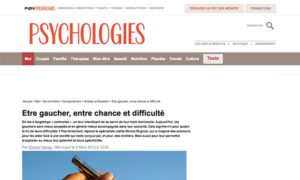 Interview with Joëlle Morice Mugnier by Elyane Vignau
Interview with Joëlle Morice Mugnier by Elyane Vignau
“They have long been “frustrated” by being told not to use their dominant hand. “Today, left-handers are better accepted and generally better supported over the course of their education. “But does this really mean an end to their difficulties? “Not necessarily, replies specialist Joëlle Morice Mugnier, who has conceived solutions to help them deal with a society designed by, and for, right-handers, but also to allow them to make the most of their potential and their specificities.”
Lire l’article
Interview : Helping Left-Hander
 By Anne Laure Blanc
By Anne Laure Blanc
Fondation pour l’École (Foundation for School) Site – Le blog de la liberté scolaire (The School Freedom blog) – 30th September 2011
If the most famous of left-handers is no less than Leonardo da Vinci, how many others have suffered from being considered awkward, clumsy, “the wrong way round”; how many experience difficulties when reading, writing and counting? Left-handed herself, Mrs Joëlle Morice Mugnier, a psychotherapist and Vittoz Method practitioner, offers a pedagogy based on laterality structuring: laterapedagogy. She has summarised her research in her book Gauchers en difficulté – La latérapédagogie, une richesse inexploitée (Pierre Téqui, 2011). She answers a few questions for us here.
Yourself left-handed, you have faced various challenges since your childhood. What are the most common ones?
It is often said that since left-handers are (it seems) no longer frustrated in terms of hand use in order to write, they no longer suffer from their left-handedness. Everyone thinks that all is “fine and dandy” for them. There are indeed many ergonomic tools to make their everyday life easier: tin openers, scissors, etc. (See www.lesgauchers.com.) I am amongst the 14% of left-handers in the West who, although they write with their dominant hand, remain frustrated by the left-to-right writing, reading, even thinking direction. We read, write and often think in a “closing” direction. It is therefore not just about a few door handles that open the wrong way round for us left-handers that can give our intellect, mental state or affects a hard time. The impact of frustration of the conventional direction on the brain is greater than one may think.
My chaotic schooling illustrates this, as do many patients’ testimonials. Those years turned into an uphill battle: poor hand-writing, slow and broken-up reading to the point of being put off. Add to that possible concentration, comprehension, memorisation and restitution issues, a lower self-confidence… Such an experience at school can result in poor results at best, or in giving up on further education at worst.
One can be left- or right-handed, but also left/right-eyed or left/right-footed. How does this work?
As you will have noticed, the world is not made of homogeneous right-handers only, i.e. individuals whose laterality is fixed to the right, be it with regards to their eyes, their feet, their hands, or even their ears. There are also homogeneous left-handers, who are entirely lateralised to the left. What is more, we live here in a system designed by and for right-handers. So why are there still some left-handers? Probably because they have shown resistance! And why are some individuals “right-handed/left-eyed” or “left-handed/right-eyed”? (We will talk about foot and ear laterality some other time, maybe.) From experience, I think it is fair to say that, in both cases, the person is a left-hander in mutation.
What I mean is this: whether it is the right hand in the first case or the right eye in the second, a maximum, subconscious, adaptation has probably taken place to the point of integrating the left-to-right system for the use of these organs. The left eye in the first case and the hand in the second, however, have shown resistance to the system. We will see that some symptoms can be a reflexion of that.
Dyslexia, dysorthographia, dyscalculia, stuttering, migraines, emotional hyper-reactivity… What if all these disorders were due, in part or in full, to a bad laterality ?
There is no such thing as a bad laterality per se. The issue is that for the too many ill-lateralised individuals – there are millions of them – the cognitive system is not adapted to the functioning of their brain. Yet, there are fortunately many heterogeneous left- and right-handers who are doing well and who have found a good balance in life. If the brains of left-handers had been able to evolve in a left-handed civilisation where everything was written from right to left to be read from right to left and therefore thought from right to left too, there would presumably have been no “dys- that and the other”.
For example :
- A dyslexic person, usually left-handed and/or left-eyed, presented with the letter “b” tends to see a “d” at first, and then a “b” depending on their dominant sense of direction. It is as if there was some confusion between “b” and “d”. The person is in a complete state of “fusion/confusion”.
- Left-handers, in our right-handed society, need to use the left hemisphere of their brain twice as much as right-handers for their cognitive activities, since we now know that most left-handers have a second language centre on the left. It is this same left hemisphere that activates, via the limbic system, their affective, emotional, intuitive and creative capacities. Their “left brain” is never really quiet or at rest.
- Migraines, ophthalmic headaches, etc. can occur while reading if the left eye is dominant. This is because, as the left eye wants to read in its natural right-to-left opening direction, it feels as if it was strenuously pushing the words when reading from left to right. As a result, as left-eyed people have to turn the letters “the right way round” to understand them, they will often need to read the sentence two, three, sometimes up to six times in order to get to the meaning of the text.
- Finally, a left-hander who perceives the environment in which they are growing up as not being that coherent, fitting or respectful of their own functioning can develop many symptomatic disorders that can go as far as withdrawing into their own bubble and displaying an autistic type of behaviour, however mild.
This is all subconscious, of course.
Unfortunately, throughout the past centuries (and too much today still), the left hand has been “the bad hand” or “the Devil’s hand”. Tough luck for left-handers in civilisations where writing is from right to left. Which leads me to think that today, because left-handers are less and less frustrated in terms of hand use, those who write Hebrew and Arabic are the happiest left-handers in the world!
What simple tips would you give parents when they realise that their young child seems to be left-handed? How can nursery school teachers help little left-handers ?
At a behavioural level, it now goes without saying that the parent or adult will let the child pick up their spoon or pen with their left hand, kick the ball with their left foot and take a photo with their left eye if they so wish.
What simple tips can I give you? All my previous explanations could make your head spin: left-to-right, right-to-left sense of direction, true or false left-handers… It can be rather confusing! In a way, maybe. It took me over seventeen years to decipher the actual mechanics and implications of our left-to-right system and to discover those of the homogeneous as well as heterogeneous left-handers before I could suggest workable solutions.
This is how it works: allow the left-hander to function in their dominant opening direction so that they may develop according to their normality while giving them the tools to adapt to the system they live in.
Laterapedagogy, when a child start to learn, and lateratherapy, as a “recovery” approach for grown-ups, caters for the demand from many individuals wishing to enjoy a better structured laterality and clear certain symptoms. Here is a very simple exercise: instead of immediately requesting of the little one that they draw loops, bridges, bowls, etc. from left to right to adopt the conventional writing direction, let them draw them from right to left. You will notice that they spontaneously place their hand beneath the pregraphics. Once each series is mastered, encourage them to draw them in “boustrophedon”, or “oscillating” arabesques: the first line from right to left, the next from left to right, etc.
One of the many advantages that I will leave you to discover in Gauchers en difficulté is that there is no longer a need to twist the wrist: as it keeps going, the left hand, naturally placed under the right-to-left pregraphics, will more than likely stay there for the left-to-right direction. The wrist is no longer contorted, the person’s back adopts a healthier posture and the letters are shaped properly.
You have created practical tools to help with structuring one’s laterality. Could you describe them briefly?
There is no magic here and it only requires a minimum of common sense, patience and adaptation to each type of left-handedness: total or homogeneous, heterogeneous, “unaware” or “false right-handers”. This is why laterapedagogy is mostly aimed at left-handers and people seeking a better laterality, but also at parents, teachers, speech therapists, graphotherapists, graphologists, orthoptists, psychomotricians, etc. so that they can take over by adopting the method and tools and adapt them to their own practice. You can become familiar with it by reading the book and more particularly by attending courses (www.gaucher-droitier.com).
The tools currently available are the arrow card and the tracing-paper notebook.
There is nothing to indicate to a child who cannot read yet what the reading direction is until an adult shows the “correct” direction by a horizontal, linear movement of their finger. But this is hardly ever mentioned, let alone explained. The arrow card enables the child to become fully aware of their dominant opening direction when drawing, say, loops from right to left. With the arrow turned the other way and placed above the page, they know they are practising left-to-right drawing. The same applies to learn how to write letters, words and sentences and of course to read. With boustrophedon writing and the arrow card, the child’s brain integrates progressively the conventional sense of direction.
The tracing-paper notebook has become vital for people of all ages who must write a text. In fact, they often write from right to left, and have done so for a long time, but behind closed doors… Many can testify that writing this way on tracing paper has unblocked their cognitive
processes: these left-handers experience a more relaxed concentration and therefore understand and memorise better and find their words more easily. If they previously got stuck on mathematical calculations, the strategies and solutions now come easily. Remember: for a left-hander facing an operation, units must be on the left and the tens on the right, same thing for the result!
I am grateful to teachers who have accepted that their left-handed students work on a tracing-paper notebook; they acknowledge that it is easy enough to simply turn the page over to correct the exercises. I now focus on two projects: find a company that will agree to manufacture the double-sided whiteboard®. (A word to the wise…!) Its key feature is that it is mostly made of transparent Plexiglas®. It therefore offers the same advantages as tracing paper and is usually used like scrap paper. What’s more, it’s erasable. You can view a demo of mirror-writing on the website: www.gaucher-droitier.com.
The exercise workbook for reading and writing is also useful. I already have a lot of demand to help young children in Reception and Key Stage 1.
I am working on these projects and hope to announce their release soon!
Are you a true left-hander? Are you a true right-hander?
Are you a true left-hander? Are you a true right-hander?
June 2014 bulletin of the Association Lyonnaise de Graphologie, by Philippine ROLLET
Download article
Left-handers: are prejudices having a hard time?
Left-handers: are prejudices having a hard time?
June 2014 bulletin of the Association Lyonnaise de Graphologie, by Marie Dagman on 13 August 2014
